Assessing Hydropower Impacts on Flood and Drought Hazards in the Lancang–Mekong River Using CNN-LSTM Machine Learning
Abstract
1. Introduction
2. Study Area
3. Materials and Methods
3.1. Data Sources
3.2. Research Methods
3.2.1. Trend Analysis
3.2.2. Mutation Analysis
- (1)
- Data Preparation: Collect time series data for two variables. In this study, the variables were precipitation and the corresponding runoff.
- (2)
- Cumulative Calculation: Perform cumulative calculations for both variables to obtain cumulative value series. If precipitation is denoted as (P) and corresponding runoff as (Q), calculate the cumulative values of (P) and (Q).
- (3)
- Plotting the Curve: Plot the double mass curve with the cumulative precipitation on the x-axis and the cumulative runoff on the y-axis.
- (4)
- Curve Analysis: By observing the shape and slope changes in the double mass curve, the relationship between the two variables can be analyzed. If the curve shows a linear relationship, it indicates a stable proportional relationship between precipitation and runoff. If the curve shows significant deviations, it may suggest the influence of external factors, such as land use changes or climate change.
3.2.3. Runoff Simulation Based on Machine Learning Models
3.2.4. Flood and Drought Disaster Identification
4. Results
4.1. Runoff Restoration Simulation Results
4.2. Analysis of Extreme Precipitation Trends
4.3. Characteristics of Flood and Drought Hazards
5. Discussion
5.1. Contribution of Hydropower Development to Flood Control
5.2. Contribution of Hydropower Development to Drought Mitigation
5.3. Contribution of Hydropower Development to Regulating Drought–Flood Transitions
5.4. Model Limitation
6. Conclusions
- 1.
- Increased Frequency and Spatial Distribution of Extreme Precipitation Events
- 2.
- Contribution of Hydropower Development to Flood Control
- 3.
- Mitigating Effect of Hydropower Development on Droughts
- 4.
- Regulatory Role in Drought–Flood Transitions
- 5.
- Combined Impact of Climate Change and Human Activities
Author Contributions
Funding
Data Availability Statement
Conflicts of Interest
Abbreviations
| CNN-LSTM | Convolutional Neural Network–Long Short-Term Memory |
| GA | Genetic Algorithm |
References
- Chen, D.; Liu, J.; Tang, Q. Water Resources in the Lancang-Mekong River Basin: Impact of Climate Change and Human Interventions; Springer Nature: Berlin/Heidelberg, Germany, 2024. [Google Scholar]
- Penny, J.; Khadka, D.; Babel, M.; Alves, P.; Djordjević, S.; Chen, A.S.; Loc, H.H. Integrated assessment of flood and drought hazards for current and future climate in a tributary of the Mekong river basin. J. Water Clim. Change 2023, 14, 4424–4443. [Google Scholar] [CrossRef]
- Räsänen, T.A.; Koponen, J.; Lauri, H.; Kummu, M. Downstream hydrological impacts of hydropower development in the Upper Mekong Basin. Water Resour. Manag. 2012, 26, 3495–3513. [Google Scholar] [CrossRef]
- Lu, X.X.; Li, S.; Kummu, M.; Padawangi, R.; Wang, J.J. Observed changes in the water flow at Chiang Saen in the lower Mekong: Impacts of Chinese dams? Quat. Int. 2014, 336, 145–157. [Google Scholar] [CrossRef]
- Mohammed, I.N.; Bolten, J.D.; Srinivasan, R.; Lakshmi, V. Satellite observations and modeling to understand the Lower Mekong River Basin streamflow variability. J. Hydrol. 2018, 564, 559–573. [Google Scholar] [CrossRef]
- Nesbitt, H.; Johnston, R.; Solieng, M. Mekong River water: Will river flows meet future agriculture needs in the Lower Mekong Basin? Water Agric. 2004, 116, 86–104. [Google Scholar]
- Ishankha, W.C.A.; Shrestha, S.; Van Binh, D.; Kantoush, S.A. Comprehensive assessment of cascading dams-induced hydrological alterations in the Lancang-Mekong river using machine learning technique. J. Environ. Manag. 2024, 371, 123082. [Google Scholar] [CrossRef]
- Cheng, H.; Wang, T.; Yang, D. Quantifying the regulation capacity of the Three Gorges Reservoir on extreme hydrological events and its impact on flow regime in a changing climate. Water Resour. Res. 2024, 60, e2023WR036329. [Google Scholar] [CrossRef]
- Yun, X.; Tang, Q.; Sun, S.; Wang, J. Reducing climate change induced flood at the cost of hydropower in the Lancang-Mekong River Basin. Geophys. Res. Lett. 2021, 48, e2021GL094243. [Google Scholar] [CrossRef]
- Martel, J.L.; Brissette, F.; Arsenault, R.; Turcotte, R.; Castañeda-Gonzalez, M.; Armstrong, W.; Mailhot, E.; Pelletier-Dumont, J.; Rondeau-Genesse, G.; Caron, L.-P. Assessing the adequacy of traditional hydrological models for climate change impact studies: A case for long-short-term memory (LSTM) neural networks. EGUsphere 2024, 2024, 1–44. [Google Scholar] [CrossRef]
- Hoang, L.P.; van Vliet, M.T.H.; Kummu, M.; Lauri, H.; Koponen, J.; Supit, I.; Leemans, R.; Kabat, P.; Ludwig, F. The Mekong’s future flows under multiple drivers: How climate change, hydropower developments and irrigation expansions drive hydrological changes. Sci. Total Environ. 2019, 649, 601–609. [Google Scholar] [CrossRef]
- Yu, Y.; Bo, Y.; Castelletti, A.; Dumas, P.; Gao, J.; Cai, X.; Liu, J.; Kahil, T.; Wada, Y.; Hu, S.; et al. Transboundary cooperation in infrastructure operation generates economic and environmental co-benefits in the Lancang-Mekong River Basin. Nat. Water 2024, 2, 589–601. [Google Scholar] [CrossRef]
- Yun, X.; Tang, Q.; Wang, J.; Liu, X.; Zhang, Y.; Lu, H.; Wang, Y.; Zhang, L.; Chen, D. Impacts of climate change and reservoir operation on streamflow and flood characteristics in the Lancang-Mekong River Basin. J. Hydrol. 2020, 590, 125472. [Google Scholar] [CrossRef]
- Hoanh, C.T.; Jirayoot, K.; Lacombe, G.; Srinetr, V. Impacts of Climate Change and Development on Mekong Flow Regimes; First assessment-2009; International Water Management Institute: Colombo, Sri Lanka, 2010. [Google Scholar]
- Hecht, J.S.; Lacombe, G.; Arias, M.E.; Dang, T.D.; Piman, T. Hydropower dams of the Mekong River Basin: A review of their hydrological impacts. J. Hydrol. 2019, 568, 285–300. [Google Scholar] [CrossRef]
- Gupta, A.; Hock, L.; Huang, X.; Chen, P. Evaluation of part of the Mekong River using satellite imagery. Geomorphology 2002, 44, 221–239. [Google Scholar] [CrossRef]
- Liu, J.; Chen, D.; Mao, G.; Irannezhad, M.; Pokhrel, Y. Past and future changes in climate and water resources in the lancang–mekong River Basin: Current understanding and future research directions. Engineering 2022, 13, 144–152. [Google Scholar] [CrossRef]
- Piman, T.; Cochrane, T.A.; Arias, M.E.; Green, A.; Dat, N.D. Assessment of flow changes from hydropower development and operations in Sekong, Sesan, and Srepok rivers of the Mekong basin. J. Water Resour. Plan. Manag. 2013, 139, 723–732. [Google Scholar] [CrossRef]
- Nalbantis, I.; Koutsoyiannis, D. A parametric rule for planning and management of multiple-reservoir systems. Water Resour. Res. 1997, 33, 2165–2177. [Google Scholar] [CrossRef]
- Ahmed, K.; Shahid, S.; Chung, E.-S.; Ismail, T.; Wang, X. Spatial distribution of secular trends in annual and seasonal precipitation over Pakistan. Clim. Res. 2017, 74, 95–107. [Google Scholar] [CrossRef]
- Tabari, H.; Talaee, P.H. Temporal variability of precipitation over Iran: 1966–2005. J. Hydrol. 2011, 396, 313–320. [Google Scholar] [CrossRef]
- Mann, H.B. Nonparametric tests against trend. Econometrica 1945, 13, 245–259. [Google Scholar] [CrossRef]
- Liu, Y.; Wang, F.; Lin, Y.; Cao, L.; Zhang, S.; Ge, W.; Han, J.; Chen, H.; Shi, S. Assessing the contributions of human activities to runoff and sediment transport change: A method for break point identification in double mass curves based on model fitting. J. Hydrol. Reg. Stud. 2023, 50, 101589. [Google Scholar] [CrossRef]
- Kratzert, F.; Klotz, D.; Shalev, G.; Klambauer, G.; Hochreiter, S.; Nearing, G. Towards learning universal, regional, and local hydrological behaviors via machine learning applied to large-sample datasets. Hydrol. Earth Syst. Sci. 2019, 23, 5089–5110. [Google Scholar] [CrossRef]
- Shoorkand, H.D.; Nourelfath, M.; Hajji, A. A hybrid CNN-LSTM model for joint optimization of production and imperfect predictive maintenance planning. Reliab. Eng. Syst. Saf. 2024, 241, 109707. [Google Scholar] [CrossRef]
- Zhao, Q.; Zhang, X.; Li, C.; Xu, Y.; Fei, J.; Hao, F.; Song, R. Diverse vegetation response to meteorological drought from propagation perspective using event matching method. J. Hydrol. 2025, 653, 132776. [Google Scholar] [CrossRef]
- Hall, J.; Arheimer, B.; Borga, M.; Brázdil, R.; Claps, P.; Kiss, A.; Kjeldsen, T.R.; Kriaučiūnienė, J.; Kundzewicz, Z.W.; Lang, M.; et al. Understanding flood regime changes in Europe: A state-of-the-art assessment. Hydrol. Earth Syst. Sci. 2014, 18, 2735–2772. [Google Scholar] [CrossRef]
- Ma, Q.; Li, Y.; Liu, F.; Feng, H.; Biswas, A.; Zhang, Q. SPEI and multi-threshold run theory based drought analysis using multi-source products in China. J. Hydrol. 2023, 616, 128737. [Google Scholar] [CrossRef]
- Van Loon, A.F.; Laaha, G. Hydrological drought severity explained by climate and catchment characteristics. J. Hydrol. 2015, 526, 3–14. [Google Scholar] [CrossRef]
- Du, Y.; Bao, A.; Zhang, T.; Ding, W. Quantifying the impacts of climate change and human activities on seasonal runoff in the Yongding River basin. Ecol. Indic. 2023, 154, 110839. [Google Scholar] [CrossRef]
- Wang, S.; Chen, F.; Hu, M.; Chen, Y.; Cao, H.; Yue, W.; Zhao, X. Past, present and future changes in the annual streamflow of the Lancang-Mekong River and their driving mechanisms. Sci. Total Environ. 2024, 947, 174707. [Google Scholar] [CrossRef]
- Gudmundsson, L.; Boulange, J.; Do, H.X.; Gosling, S.N.; Grillakis, M.G.; Koutroulis, A.G.; Leonard, M.; Liu, J.; Schmied, H.M.; Papadimitriou, L.; et al. Globally observed trends in mean and extreme river flow attributed to climate change. Science 2021, 371, 1159–1162. [Google Scholar] [CrossRef]
- Yun, X.; Song, J.; Wang, J.; Bao, H. Modelling to assess the suitability of hydrological-hydrodynamic model under the hydropower development impact in the Lancang-Mekong river basin. J. Hydrol. 2024, 637, 131393. [Google Scholar] [CrossRef]
- Yu, Y.; Zhao, J.; Li, D.; Wang, Z. Effects of hydrologic conditions and reservoir operation on transboundary cooperation in the Lancang–Mekong River Basin. J. Water Resour. Plan. Manag. 2019, 145, 04019020. [Google Scholar] [CrossRef]
- Carew-Reid, J. The Mekong: Strategic environmental assessment of mainstream hydropower development in an international river basin. In Routledge Handbook of the Environment in Southeast Asia; Routledge: London, UK, 2016; pp. 352–373. [Google Scholar]
- Li, D.; Marshall, L.; Liang, Z.; Sharma, A.; Zhou, Y. Bayesian LSTM with stochastic variational inference for estimating model uncertainty in process-based hydrological models. Water Resour. Res. 2021, 57, e2021WR029772. [Google Scholar] [CrossRef]
- Kwon, Y.; Cha, Y.K.; Park, Y.; Lee, S. Assessing the impacts of dam/weir operation on streamflow predictions using LSTM across South Korea. Sci. Rep. 2023, 13, 9296. [Google Scholar] [CrossRef]
- Mukherjee, S.; Mishra, A.K. Global flash drought analysis: Uncertainties from indicators and datasets. Earth’s Future 2022, 10, e2022EF002660. [Google Scholar] [CrossRef]
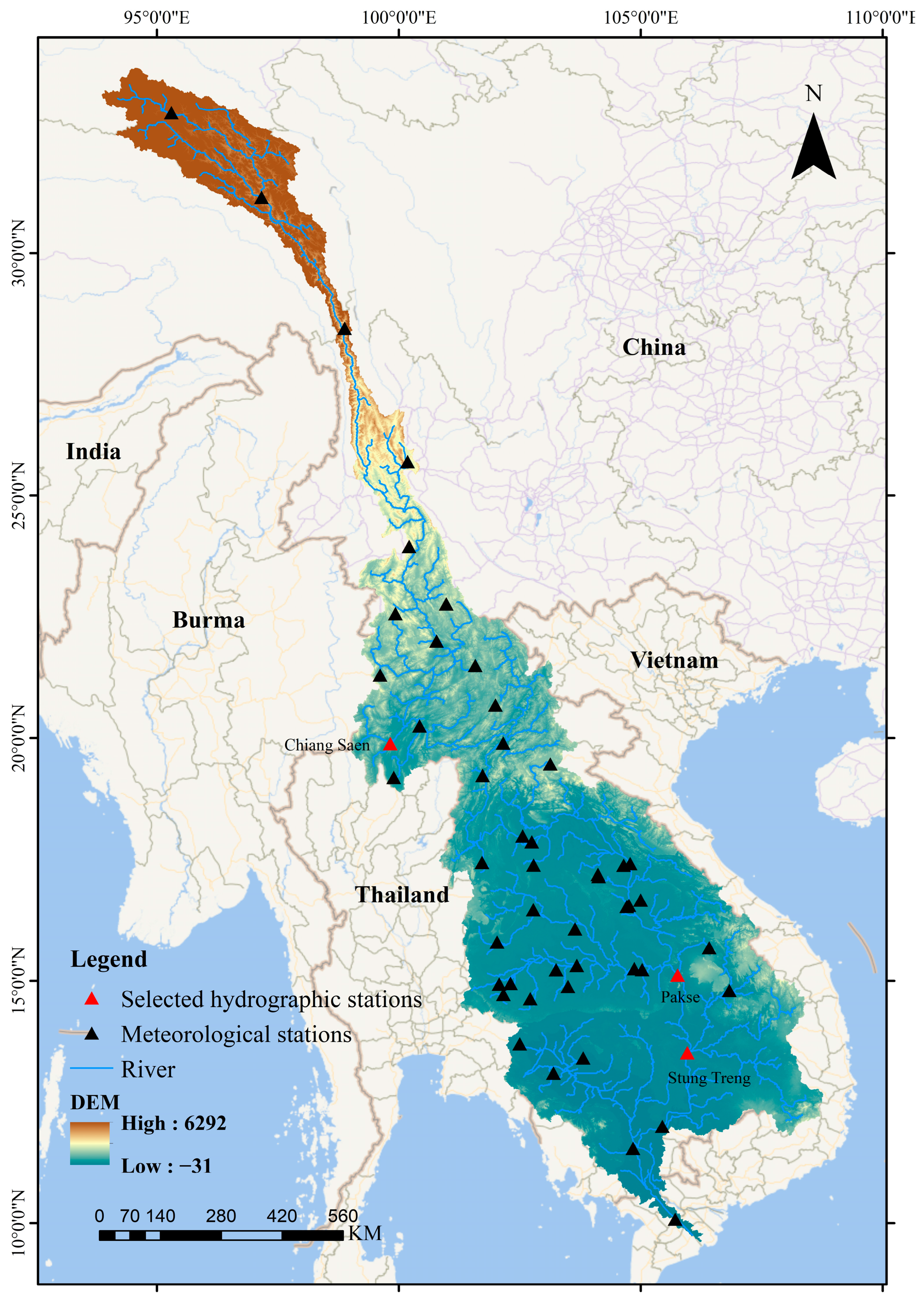
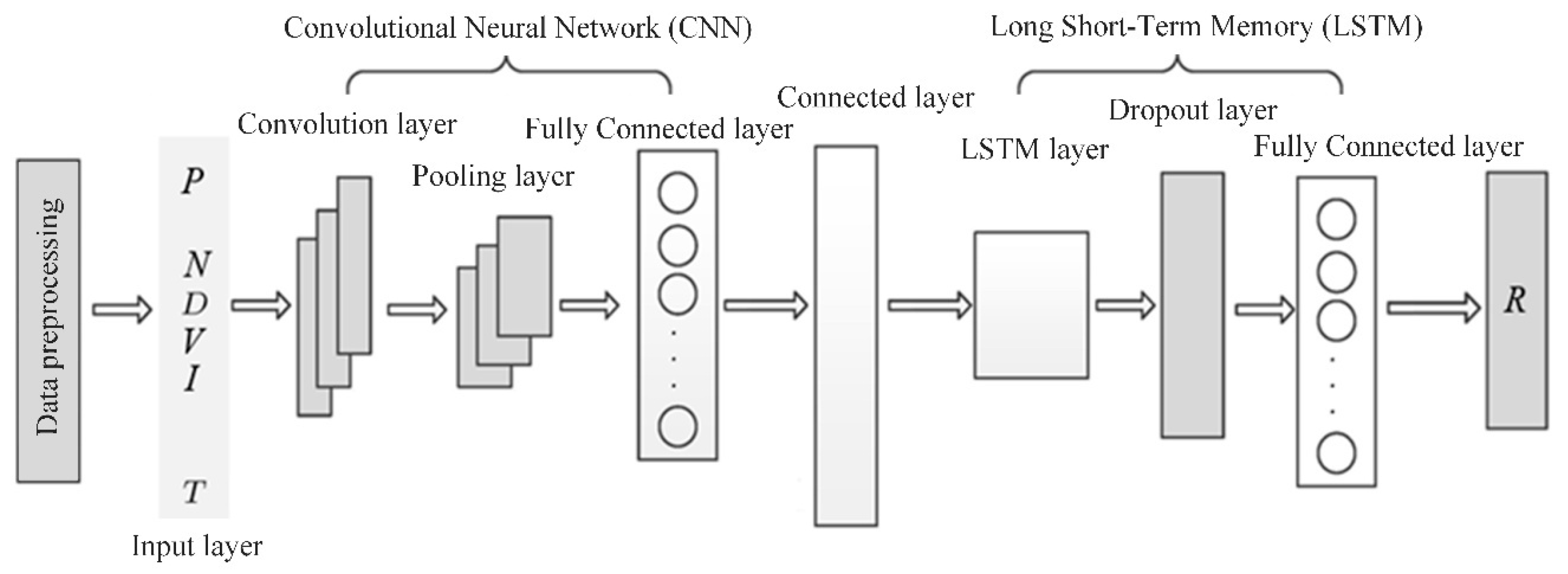
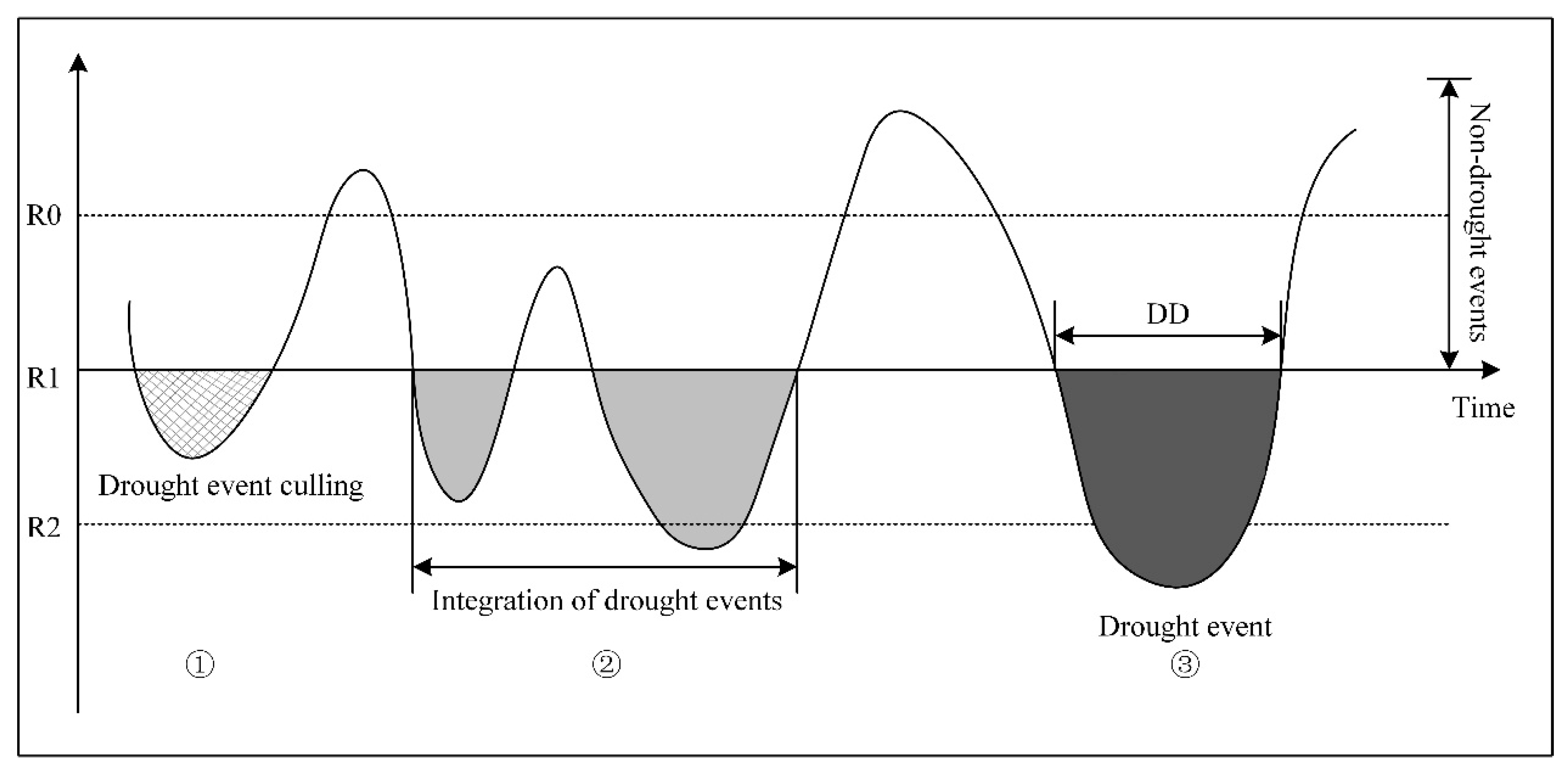
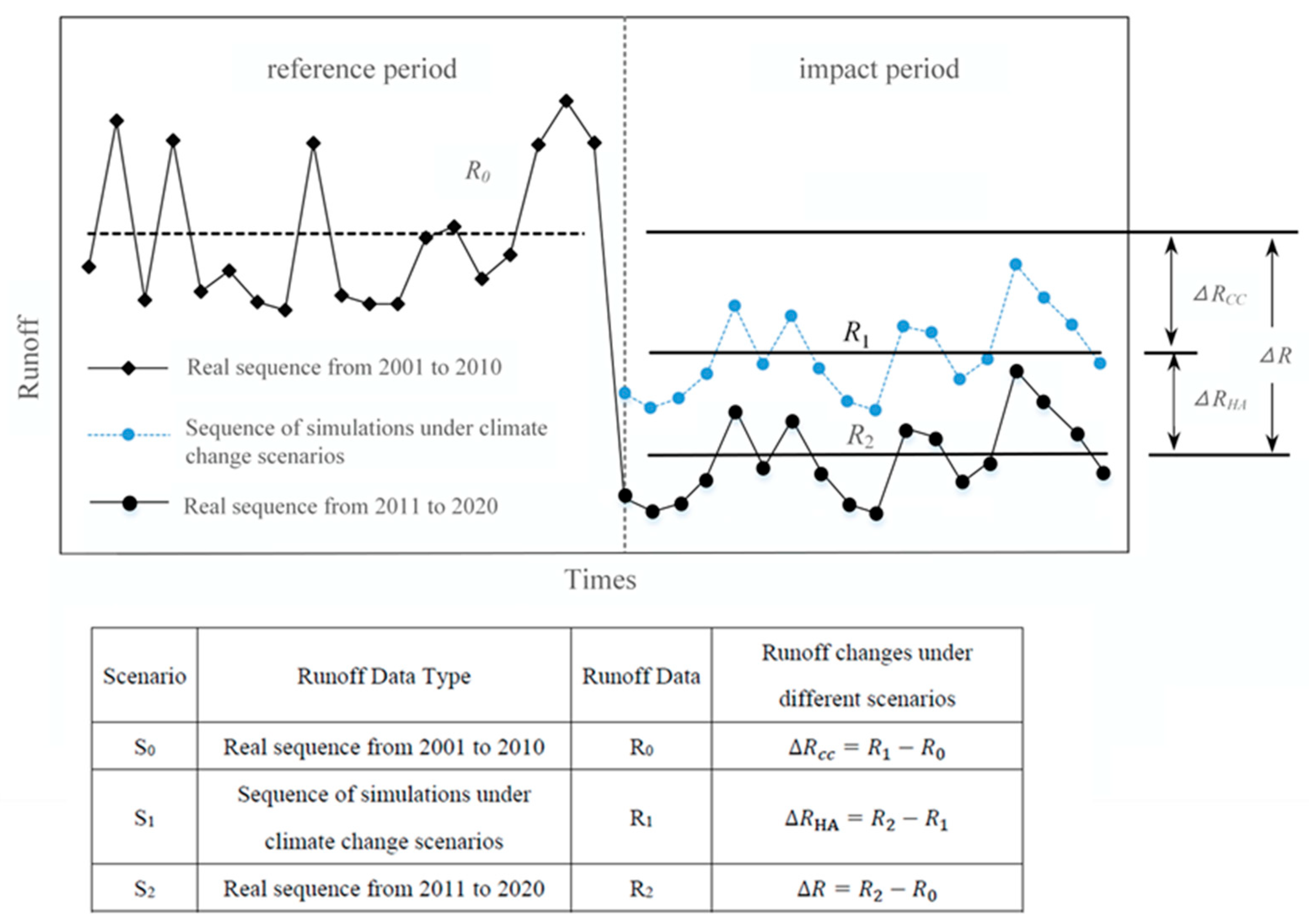



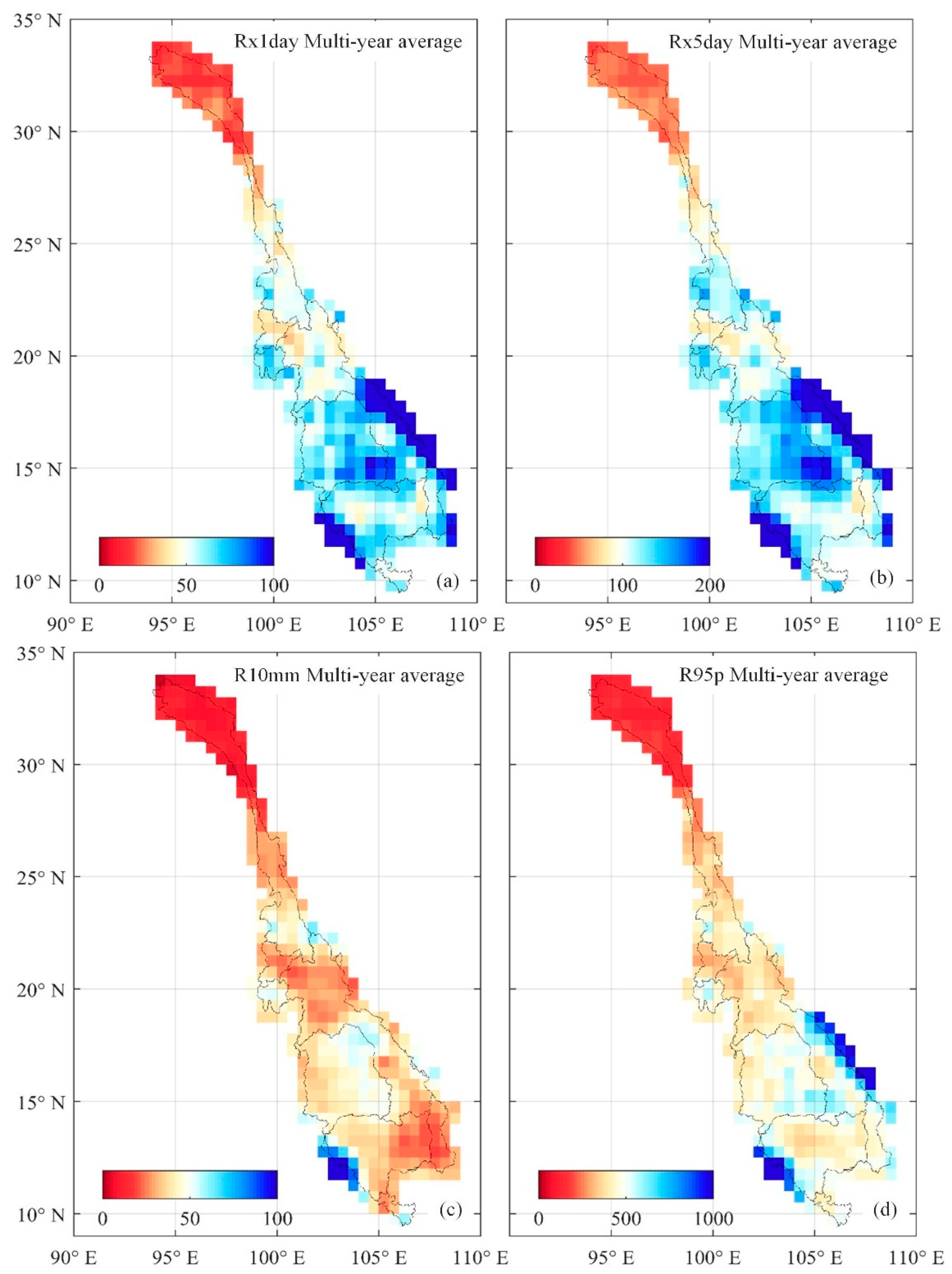
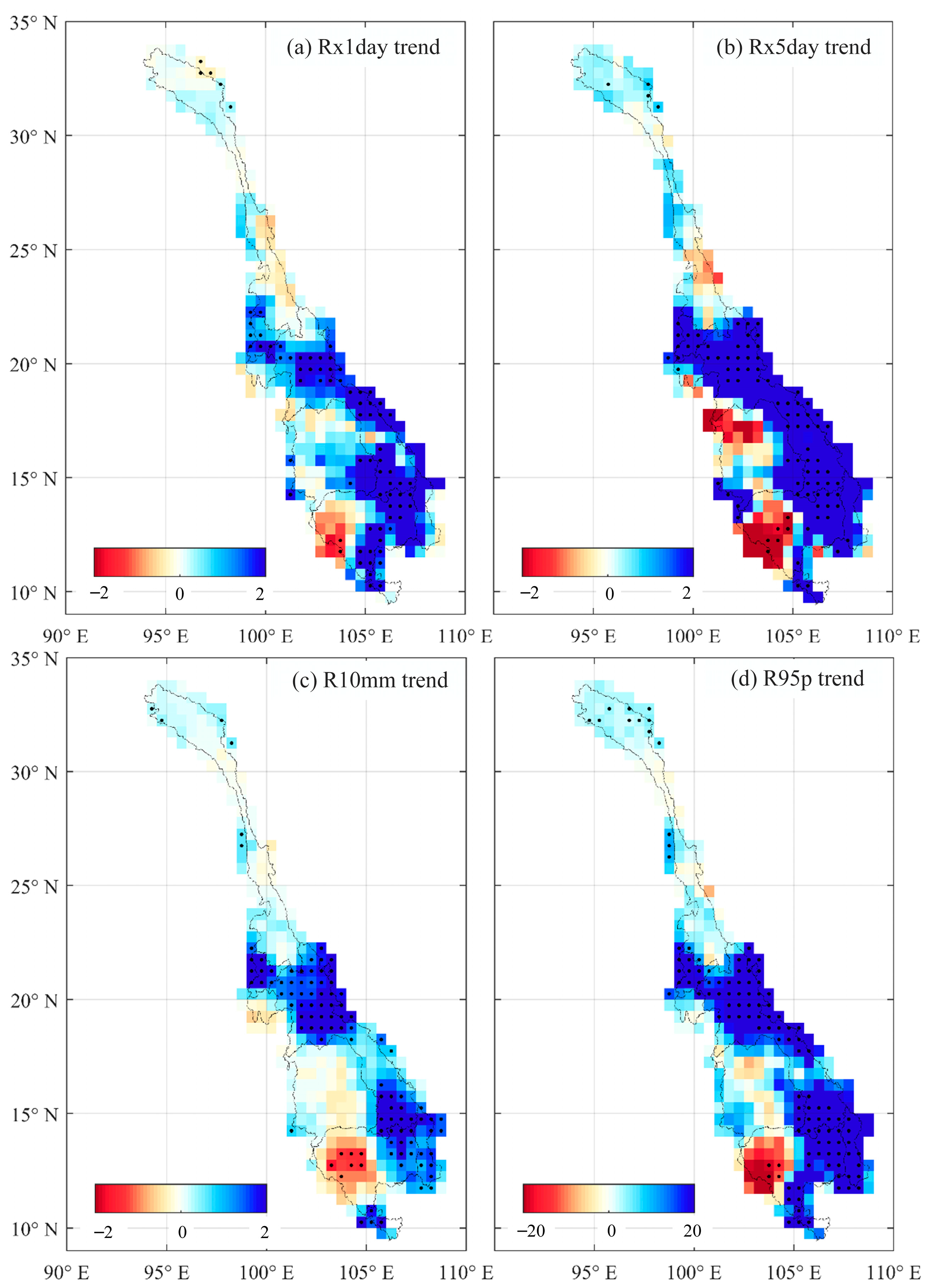
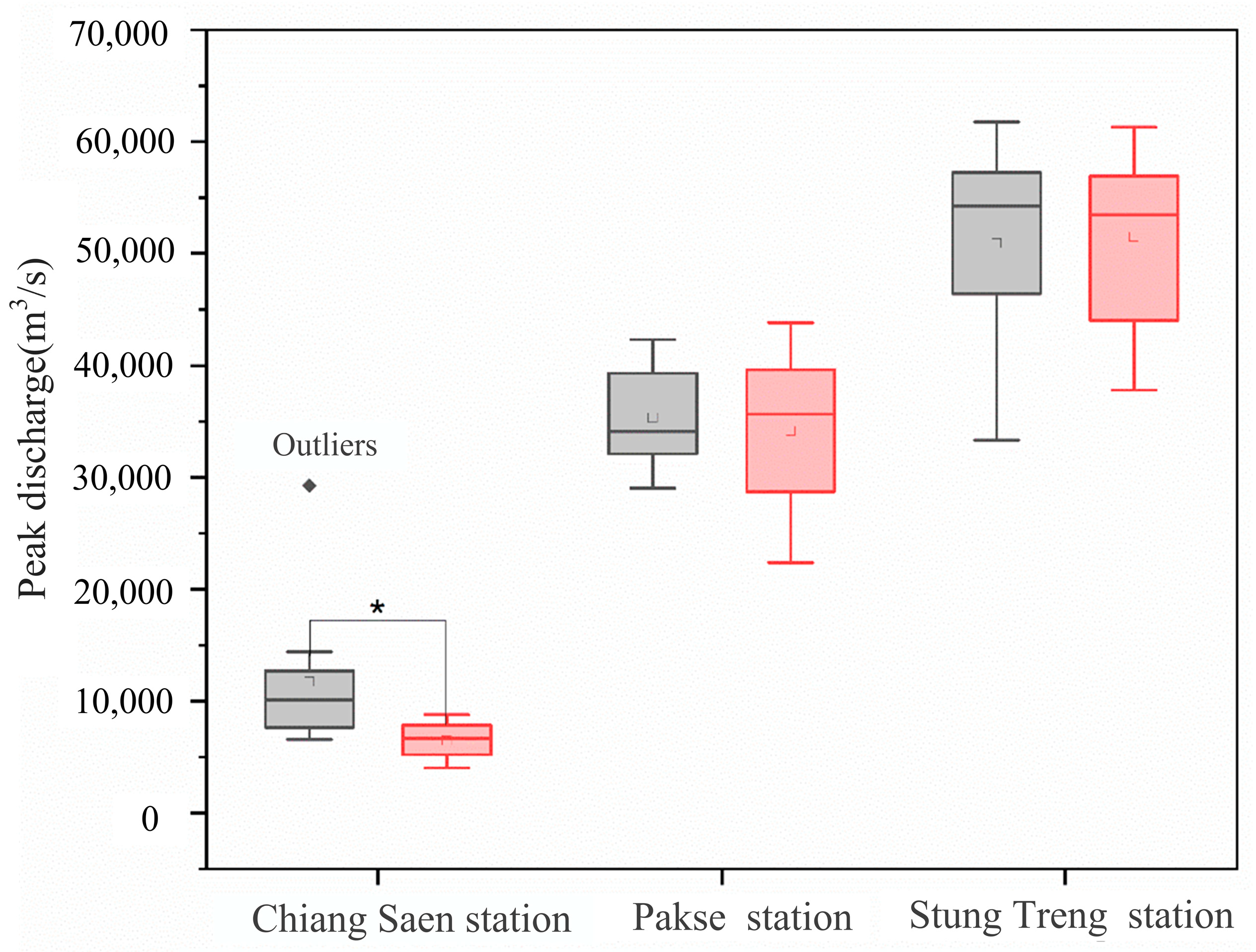

| Index Type | Description | Unit |
|---|---|---|
| Rx1day | Maximum 1-day precipitation in a year | mm |
| Rx5day | Maximum 5-day consecutive precipitation in a year | mm |
| R10mm | Annual total days with a daily precipitation of ≥10 mm | d |
| R95p | Annual cumulative precipitation on days with precipitation in the >95th percentile | mm |
| Scenario | Period | Meteorological Data | Vegetation Cover Data | Runoff Data Type | Description |
|---|---|---|---|---|---|
| S0 | Baseline | 1–10 Meteorological | 1–10 Vegetation | Observed Series | Baseline Runoff |
| S1 | Impact | 11–20 Meteorological | 11–20 Vegetation | Simulated Series | Restored Runoff |
| S2 | Impact | 11–20 Meteorological | 11–20 Vegetation | Observed Series | Observed Runoff |
| Hydrological Station | Calibration Period | Validation Period | ||||
|---|---|---|---|---|---|---|
| R2 | NS | PBIAS | R2 | NS | PBIAS | |
| Chiang Saen | 0.84 | 0.84 | −1.00 | 0.76 | 0.75 | −3.78 |
| Pakse | 0.90 | 0.90 | 5.84 | 0.81 | 0.79 | 10.41 |
| Stung Treng | 0.91 | 0.91 | 3.38 | 0.79 | 0.74 | −11.76 |
| Hydrological Station | Chiang Saen Station | Pakse Station | Stung Treng Station | ||||||
|---|---|---|---|---|---|---|---|---|---|
| Years | Flood Time | Maximum 1-Day Runoff Depth (mm) | Flood Time | Maximum 1-Day Runoff Depth (mm) | Flood Time | Maximum 1-Day Runoff Depth (mm) | |||
| Month | Day | Month | Day | Month | Day | ||||
| 2001 | 8 | 5 | 4.89 | 8 | 19 | 6.71 | 9 | 9 | 8.40 |
| 2002 | 8 | 20 | 5.81 | 8 | 22 | 6.24 | 8 | 20 | 7.86 |
| 2003 | 9 | 8 | 3.15 | 9 | 15 | 5.42 | 8 | 24 | 7.33 |
| 2004 | 9 | 15 | 4.07 | 9 | 13 | 6.11 | 9 | 23 | 7.54 |
| 2005 | 8 | 28 | 4.38 | 8 | 19 | 6.27 | 9 | 7 | 4.54 |
| 2006 | 10 | 12 | 13.4 | 8 | 30 | 5.03 | 9 | 10 | 6.50 |
| 2007 | 8 | 5 | 4.89 | 10 | 10 | 5.16 | 9 | 6 | 6.31 |
| 2008 | 8 | 10 | 6.58 | 8 | 17 | 5.41 | 9 | 12 | 7.79 |
| 2009 | 8 | 24 | 3.5 | 8 | 14 | 4.60 | 8 | 31 | 5.59 |
| 2010 | 7 | 22 | 3.01 | 9 | 3 | 5.09 | 8 | 26 | 7.43 |
| 2011 | 8 | 24 | 2.97 | 8 | 10 | 6.56 | 8 | 27 | 8.34 |
| 2012 | 7 | 25 | 4.02 | 9 | 3 | 4.31 | 8 | 7 | 7.12 |
| 2013 | 12 | 13 | 3.12 | 9 | 23 | 6.01 | 8 | 12 | 7.26 |
| 2014 | 9 | 15 | 2.38 | 8 | 1 | 5.72 | 9 | 26 | 7.74 |
| 2015 | 7 | 31 | 3.82 | 8 | 10 | 4.56 | 9 | 12 | 5.14 |
| 2016 | 8 | 19 | 2.48 | 9 | 13 | 4.66 | 9 | 15 | 7.81 |
| 2017 | 9 | 9 | 3.19 | 7 | 27 | 5.59 | 8 | 31 | 5.92 |
| 2018 | 8 | 31 | 3.6 | 7 | 30 | 6.28 | 9 | 11 | 7.28 |
| 2019 | 1 | 5 | 2.2 | 9 | 4 | 6.95 | 8 | 3 | 5.99 |
| 2020 | 8 | 16 | 1.84 | 8 | 27 | 3.55 | 9 | 3 | 7.45 |
| Hydrological Station | Chiang Saen Station | Pakse Station | Stung Treng Station |
|---|---|---|---|
| Average duration (month) | 6.56 | 5.56 | 7.56 |
| Average severity | 4.48 | 4.16 | 7.07 |
| Average peak value | 1.22 | 1.05 | 1.36 |
Disclaimer/Publisher’s Note: The statements, opinions and data contained in all publications are solely those of the individual author(s) and contributor(s) and not of MDPI and/or the editor(s). MDPI and/or the editor(s) disclaim responsibility for any injury to people or property resulting from any ideas, methods, instructions or products referred to in the content. |
© 2025 by the authors. Licensee MDPI, Basel, Switzerland. This article is an open access article distributed under the terms and conditions of the Creative Commons Attribution (CC BY) license (https://creativecommons.org/licenses/by/4.0/).
Share and Cite
Zhang, M.; Chi, B.; Gu, H.; Zhou, J.; Chen, H.; Wang, W.; Wang, Y.; Chen, J.; Yang, X.; Zhang, X. Assessing Hydropower Impacts on Flood and Drought Hazards in the Lancang–Mekong River Using CNN-LSTM Machine Learning. Water 2025, 17, 2352. https://doi.org/10.3390/w17152352
Zhang M, Chi B, Gu H, Zhou J, Chen H, Wang W, Wang Y, Chen J, Yang X, Zhang X. Assessing Hydropower Impacts on Flood and Drought Hazards in the Lancang–Mekong River Using CNN-LSTM Machine Learning. Water. 2025; 17(15):2352. https://doi.org/10.3390/w17152352
Chicago/Turabian StyleZhang, Muzi, Boying Chi, Hongbin Gu, Jian Zhou, Honggang Chen, Weiwei Wang, Yicheng Wang, Juanjuan Chen, Xueqian Yang, and Xuan Zhang. 2025. "Assessing Hydropower Impacts on Flood and Drought Hazards in the Lancang–Mekong River Using CNN-LSTM Machine Learning" Water 17, no. 15: 2352. https://doi.org/10.3390/w17152352
APA StyleZhang, M., Chi, B., Gu, H., Zhou, J., Chen, H., Wang, W., Wang, Y., Chen, J., Yang, X., & Zhang, X. (2025). Assessing Hydropower Impacts on Flood and Drought Hazards in the Lancang–Mekong River Using CNN-LSTM Machine Learning. Water, 17(15), 2352. https://doi.org/10.3390/w17152352






